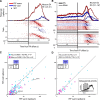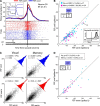Frontal Eye Field Inactivation Diminishes Superior Colliculus Activity, But Delayed Saccadic Accumulation Governs Reaction Time Increases
- PMID: 29089439
- PMCID: PMC6705743
- DOI: 10.1523/JNEUROSCI.2664-17.2017
Frontal Eye Field Inactivation Diminishes Superior Colliculus Activity, But Delayed Saccadic Accumulation Governs Reaction Time Increases
Abstract
Stochastic accumulator models provide a comprehensive framework for how neural activity could produce behavior. Neural activity within the frontal eye fields (FEFs) and intermediate layers of the superior colliculus (iSC) support such models for saccade initiation by relating variations in saccade reaction time (SRT) to variations in such parameters as baseline, rate of accumulation of activity, and threshold. Here, by recording iSC activity during reversible cryogenic inactivation of the FEF in four male nonhuman primates, we causally tested which parameter(s) best explains concomitant increases in SRT. While FEF inactivation decreased all aspects of ipsilesional iSC activity, decreases in accumulation rate and threshold poorly predicted accompanying increases in SRT. Instead, SRT increases best correlated with delays in the onset of saccade-related accumulation. We conclude that FEF signals govern the onset of saccade-related accumulation within the iSC, and that the onset of accumulation is a relevant parameter for stochastic accumulation models of saccade initiation.SIGNIFICANCE STATEMENT The superior colliculus (SC) and frontal eye fields (FEFs) are two of the best-studied areas in the primate brain. Surprisingly, little is known about what happens in the SC when the FEF is temporarily inactivated. Here, we show that temporary FEF inactivation decreases all aspects of functionally related activity in the SC. This combination of techniques also enabled us to relate changes in SC activity to concomitant increases in saccadic reaction time (SRT). Although stochastic accumulator models relate SRT increases to reduced rates of accumulation or increases in threshold, such changes were not observed in the SC. Instead, FEF inactivation delayed the onset of saccade-related accumulation, emphasizing the importance of this parameter in biologically plausible models of saccade initiation.
Keywords: computational models; frontal eye fields; reversible inactivation; saccade; superior colliculus.
Copyright © 2017 the authors 0270-6474/17/3711715-16$15.00/0.
Figures








Comment in
-
Onset Matters: How Collicular Activity Relates to Saccade Initiation during Cortical Cooling.J Neurosci. 2018 Apr 11;38(15):3616-3618. doi: 10.1523/JNEUROSCI.0169-18.2018. J Neurosci. 2018. PMID: 29643188 Free PMC article. No abstract available.
Similar articles
-
Frontal Eye Field Inactivation Reduces Saccade Preparation in the Superior Colliculus but Does Not Alter How Preparatory Activity Relates to Saccades of a Given Latency.eNeuro. 2018 Apr 17;5(2):ENEURO.0024-18.2018. doi: 10.1523/ENEURO.0024-18.2018. eCollection 2018 Mar-Apr. eNeuro. 2018. PMID: 29766038 Free PMC article.
-
Frontal eye field inactivation alters the readout of superior colliculus activity for saccade generation in a task-dependent manner.J Comput Neurosci. 2021 Aug;49(3):229-249. doi: 10.1007/s10827-020-00760-7. Epub 2020 Nov 8. J Comput Neurosci. 2021. PMID: 33161507
-
Neural mechanisms of speed-accuracy tradeoff of visual search: saccade vigor, the origin of targeting errors, and comparison of the superior colliculus and frontal eye field.J Neurophysiol. 2018 Jul 1;120(1):372-384. doi: 10.1152/jn.00887.2017. Epub 2018 Apr 18. J Neurophysiol. 2018. PMID: 29668383 Free PMC article.
-
Causal Role of Neural Signals Transmitted From the Frontal Eye Field to the Superior Colliculus in Saccade Generation.Front Neural Circuits. 2018 Aug 28;12:69. doi: 10.3389/fncir.2018.00069. eCollection 2018. Front Neural Circuits. 2018. PMID: 30210307 Free PMC article. Review.
-
Neural mechanisms underlying target selection with saccadic eye movements.Prog Brain Res. 2005;149:157-71. doi: 10.1016/S0079-6123(05)49012-3. Prog Brain Res. 2005. PMID: 16226583 Review.
Cited by
-
Onset Matters: How Collicular Activity Relates to Saccade Initiation during Cortical Cooling.J Neurosci. 2018 Apr 11;38(15):3616-3618. doi: 10.1523/JNEUROSCI.0169-18.2018. J Neurosci. 2018. PMID: 29643188 Free PMC article. No abstract available.
-
Disrupted microsaccade responses in late-life depression.Sci Rep. 2025 Jan 22;15(1):2827. doi: 10.1038/s41598-025-86399-9. Sci Rep. 2025. PMID: 39843485 Free PMC article.
-
Eye-Tracking Training Improves Inhibitory Control in Children with Attention-Deficit/Hyperactivity Disorder.Brain Sci. 2021 Mar 2;11(3):314. doi: 10.3390/brainsci11030314. Brain Sci. 2021. PMID: 33801559 Free PMC article.
-
Proof of Concept of Novel Visuo-Spatial-Motor Fall Prevention Training for Old People.Geriatrics (Basel). 2021 Jun 29;6(3):66. doi: 10.3390/geriatrics6030066. Geriatrics (Basel). 2021. PMID: 34210015 Free PMC article.
-
Focal control of non-invasive deep brain stimulation using multipolar temporal interference.Bioelectron Med. 2025 Mar 27;11(1):7. doi: 10.1186/s42234-025-00169-6. Bioelectron Med. 2025. PMID: 40140933 Free PMC article.
References
-
- Anderson RW, Keller EL, Gandhi NJ, Das S (1998) Two-dimensional saccade-related population activity in superior colliculus in monkey. J Neurophysiol 80:798–817. - PubMed
Publication types
MeSH terms
Grants and funding
LinkOut - more resources
Full Text Sources
Other Literature Sources
